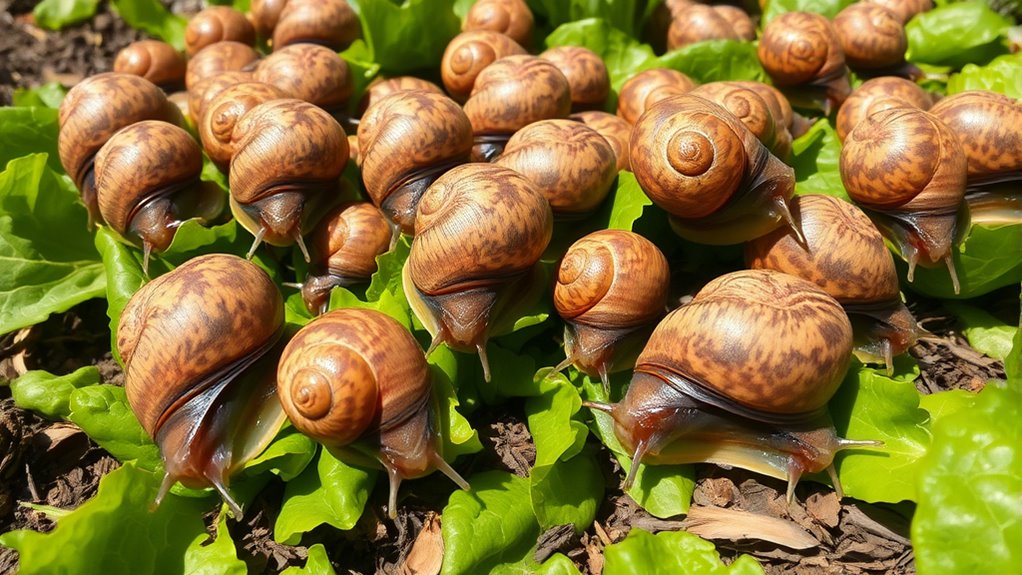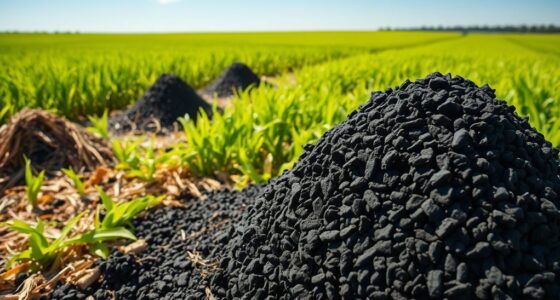Giant invasive snails are spreading rapidly across Florida, posing a serious threat to your crops and natural ecosystems. These voracious creatures outcompete native species, damage plants, and threaten biodiversity. Efforts like biological controls and community awareness are helping manage their populations. By understanding how human activities spread these snails and supporting sustainable solutions, you can play a role in protecting Florida’s environment. Keep exploring how experts are working to control these invasive pests and safeguard the state’s natural beauty.
Key Takeaways
- Invasive giant snails threaten native plants, crops, and ecosystems across Florida.
- They outcompete local species, causing ecological imbalance and long-term environmental damage.
- Management includes biological control methods and community awareness to prevent spread.
- Human activities like plant trade and soil movement facilitate snail dispersal.
- Public participation and scientific research are essential for effective control and ecosystem protection.

Have you ever wondered how invasive snails are impacting Florida’s ecosystems? These large, voracious creatures pose a serious threat to native plants, crops, and even the overall health of the environment. Their rapid spread and ability to outcompete local species make managing them a significant challenge. To curb their impact, experts are increasingly turning to biological control methods, which involve introducing natural predators or competitors to keep snail populations in check. This approach aims to restore balance without relying heavily on chemical pesticides, which can harm other wildlife and disrupt ecosystems. However, deploying biological control requires careful research to ensure that the introduced species won’t become invasive themselves. It’s a delicate balancing act, but one that could prove effective in controlling these snails sustainably. Implementing biological control is considered one of the most effective best airless paint sprayer strategies for managing invasive species without harming the environment. Additionally, ongoing scientific research is essential to identify safe and effective biological agents for snail control. Public awareness plays a critical role in addressing the invasion. Many people are unaware of just how much damage these snails can cause or how easily they can spread from one area to another. Educating residents, farmers, and visitors about the importance of inspecting plants, soil, and equipment before moving them helps prevent further dissemination. Local agencies and environmental organizations are stepping up efforts to inform the public through campaigns, workshops, and social media. By understanding the risks and recognizing invasive snails early, community members can take proactive steps to prevent their establishment and spread. This collective effort makes a significant difference, especially since most invasive species are introduced through human activity, whether it’s through plant trade or accidental transport. Additionally, public engagement can lead to more support for scientific research into biological control options. When communities understand the severity of the threat, they’re more likely to advocate for funding and policies that promote safe, effective management strategies. It also encourages responsible behavior, such as not releasing unwanted plants or snails into the wild and properly disposing of garden waste. The combination of biological control methods and heightened public awareness creates a *well-rounded* approach to managing this invasive species. While scientists work to identify suitable natural enemies, community participation ensures that efforts are sustained and far-reaching. Ultimately, controlling invasive snails in Florida isn’t just about removing a pest—it’s about protecting native ecosystems, ensuring the health of local agriculture, and preserving the natural beauty that draws so many to the state.
Frequently Asked Questions
How Do Invasive Snails Affect Native Florida Snail Species?
You might notice that invasive snails cause native snail decline by competing for food and habitat. This disrupts the natural balance, leading to ecosystem imbalance. When invasive snails thrive, native species struggle to survive, which can reduce biodiversity. Your actions to control these invasives help protect native snails and maintain healthy ecosystems. By understanding their impact, you can help support conservation efforts and preserve Florida’s unique habitats.
Can Invasive Snails Transmit Diseases to Humans or Animals?
Imagine tiny messengers quietly crossing boundaries—that’s what invasive snails can do through disease transmission. While they’re not known for directly transmitting diseases to humans, they pose zoonotic risks by harboring parasites or bacteria that could potentially spread. You should be cautious around them, especially if you have open wounds or handle them frequently. Proper hygiene and avoiding contact help minimize the risk of any unintended health issues.
What Natural Predators Help Control Invasive Snail Populations?
You might wonder what natural predators help control invasive snail populations through biological control. Predators like certain birds, mammals, and even some insects target these snails, helping restore ecological balance. Introducing or encouraging these predators can be an effective strategy, but it’s essential to contemplate ecological impacts. Proper biological control methods can keep snail numbers in check without harming native species, supporting a healthier ecosystem overall.
Are There Any Effective Eco-Friendly Methods to Eradicate These Snails?
Think of eco-friendly snail control as a gentle hand guiding the garden back to balance. You can use biological control methods, like introducing natural predators, to keep populations in check. Chemical alternatives exist, but opt for eco-conscious options that don’t harm other wildlife. These methods work like a well-orchestrated dance, helping you manage invasive snails effectively while protecting your environment and preserving the ecosystem’s harmony.
How Can Residents Identify Invasive Snails From Native Species?
To identify invasive snails, look closely at their shell shape and coloration. Invasive species often have distinct, larger shells compared to native ones, with unique colors or patterns. You might notice a more elongated or rounded shell, or unusual color hues like bright yellows or dark browns. Pay attention to these features, and if you suspect an invasive snail, report it to local authorities to help manage the threat effectively.
Conclusion
Now that these giant invasive snails are threatening Florida’s crops and ecosystems, you might wonder if there’s anything you can do. Will we stand by and let these creatures take over, or will we act to protect our environment? It’s up to all of us to stay informed, support control efforts, and help prevent further spread. After all, can we afford to ignore the impact these snails could have on our future?









